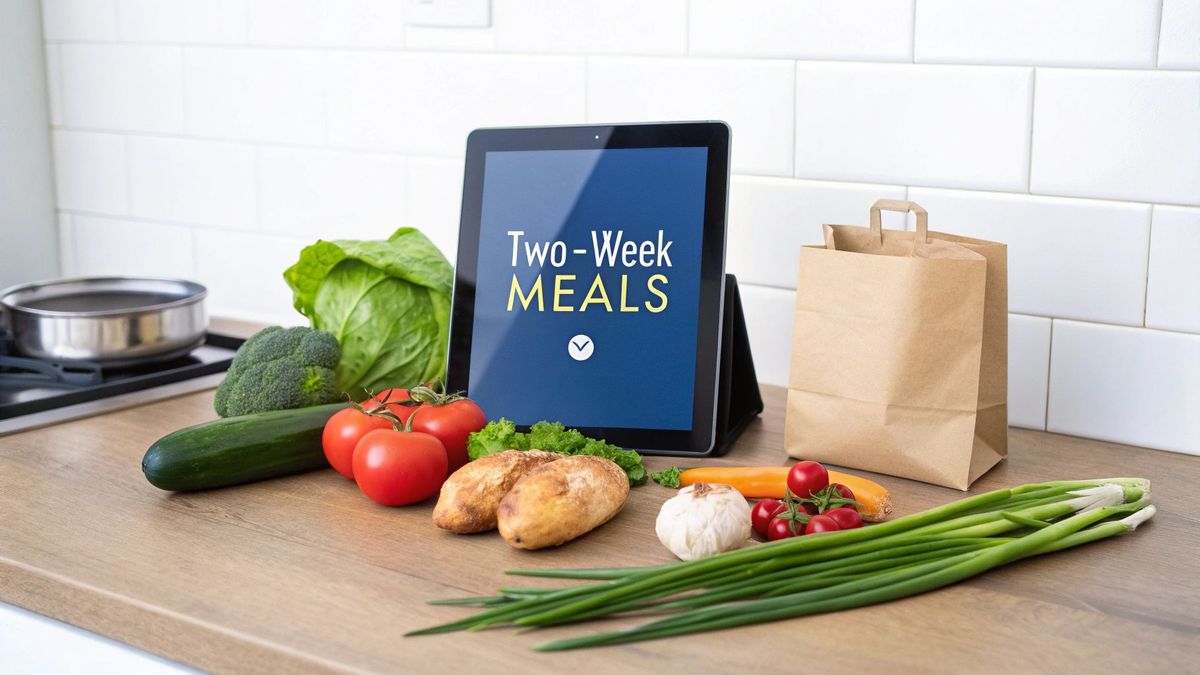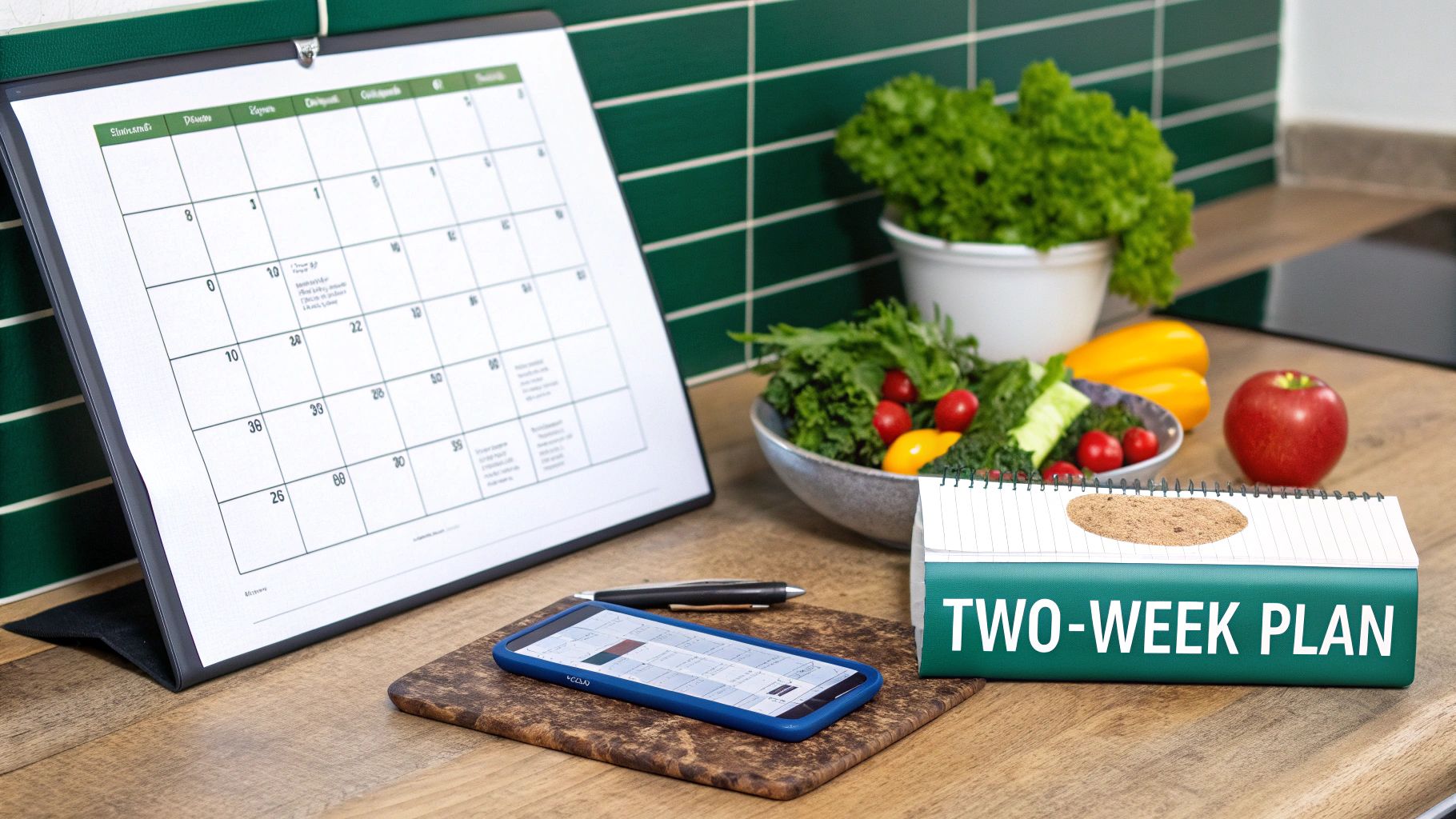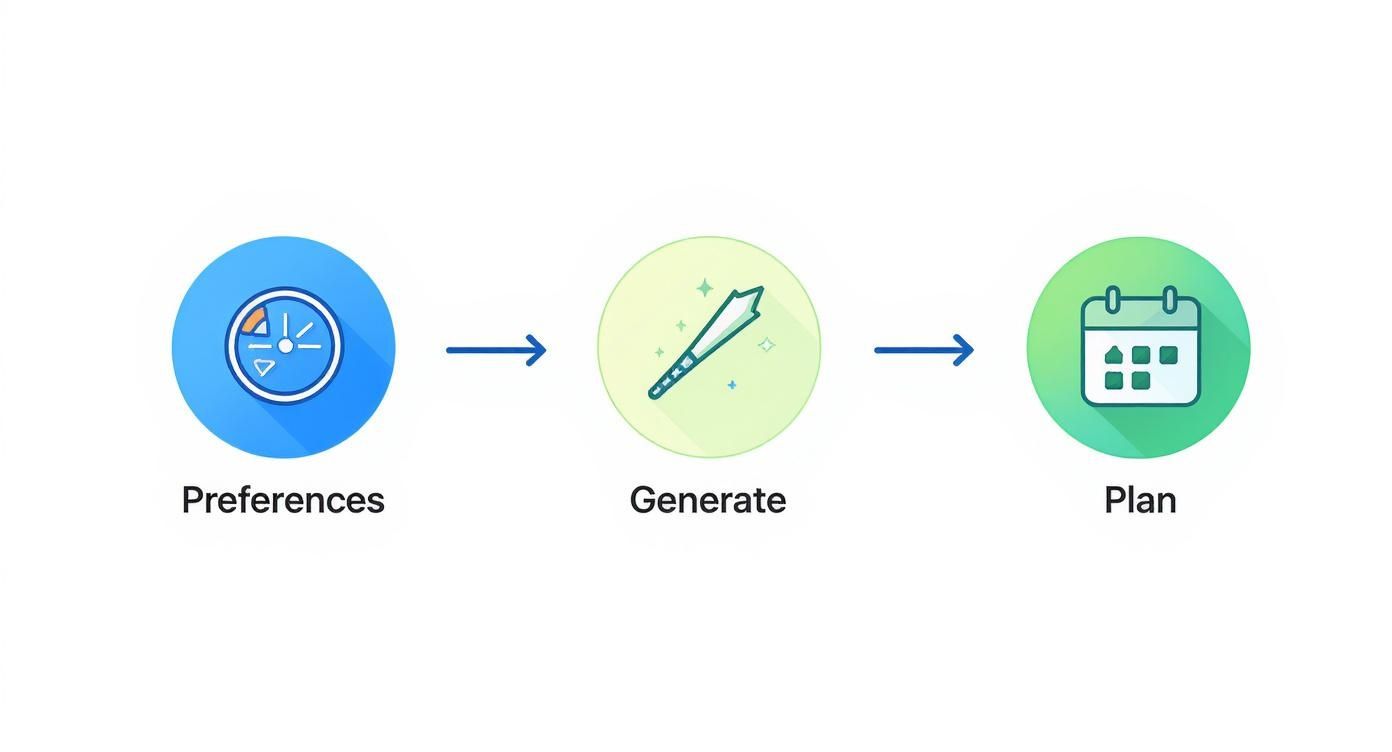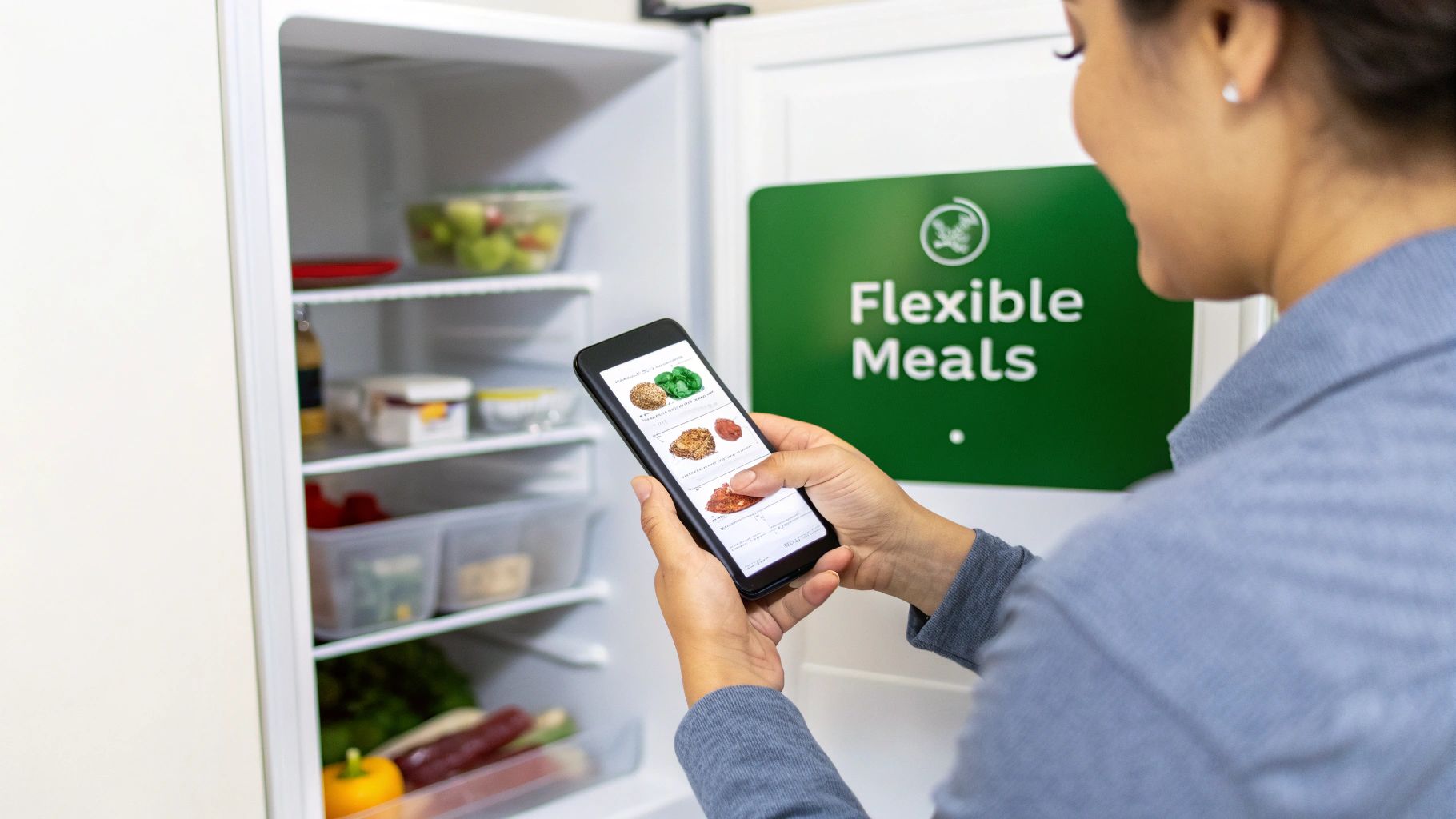Two Week Meal Plans: Quick, Budget-Friendly Dinners
Save time and money with two week meal plans. Learn to craft balanced menus in minutes and simplify dinners for busy weeks.
Ready to Simplify Your Meal Planning?
Get personalized meal plans and grocery lists automatically matched to your macro targets.

Two Week Meal Plans: Quick, Budget-Friendly Dinners
That frantic 5 PM scramble, peering into the fridge and wondering what on earth to make for dinner? We've all been there. A two week meal plan is your secret weapon against that daily chaos, striking the perfect balance between a short, repetitive one-week plan and an overwhelming monthly one.
Think of it as your roadmap to less food waste, smarter grocery shopping, and a whole lot more peace of mind.
Why Two Weeks Is Your Meal Planning Sweet Spot

Let's be honest, planning meals every single week can feel like a hamster wheel. You barely finish one grocery run before the mental gymnastics for the next one begin. It’s a relentless cycle.
On the other hand, trying to map out a full month of meals? That's a recipe for failure. Life is unpredictable. A spontaneous pizza night or a last-minute dinner invitation can throw a rigid 30-day schedule completely off the rails, leaving you with unused produce and a heavy dose of food guilt.
This is where the 14-day cycle shines. It’s the Goldilocks of meal planning—just right. You shop less, save more, and reclaim your evenings from dinner-related decision fatigue.
The Financial and Sanity Savings
Let’s talk numbers. Planning for two weeks at a time lets you get strategic at the grocery store. You can finally take advantage of those bulk-buy deals on chicken, ground beef, or pantry staples without worrying about them spoiling.
It also slashes those "I just need one thing" trips to the store, which (let's face it) always end with a cart full of impulse buys. Fewer trips mean fewer opportunities to overspend.
The mental load reduction is just as huge. Imagine knowing exactly what's for dinner every single night for the next 14 days. That's a massive amount of brainpower freed up for things you actually enjoy.
This isn't just a niche trick; it's part of a huge shift. The global meal planner market is set to explode, projected to hit USD 38.71 billion by 2035, because people are desperate for smart systems like the two week meal plan. You can dig deeper into this growing industry and its market trends.
Here's a quick look at how extending your meal plan to two weeks is a game-changer for your wallet and your sanity.
One Week vs Two Week Meal Plan Comparison
| Feature | One-Week Plan | Two-Week Plan |
| Grocery Trips | Weekly, often with extra "quick trips." | One major trip every two weeks. |
| Shopping Strategy | Standard sizes, often missing bulk deals. | Ability to buy in bulk and save money. |
| Food Waste | Higher risk for perishable items. | Lower waste due to better planning. |
| Variety | Can feel repetitive very quickly. | More room for diverse meals and cuisines. |
| Mental Load | Constant "what's next week?" thinking. | Frees up mental space for two weeks at a time. |
| Flexibility | Less room to adapt to sales or schedule changes. | Easier to plan around leftovers and pantry items. |
The takeaway is clear: doubling your planning window from seven to fourteen days offers exponential benefits in savings, stress reduction, and overall efficiency.
A two-week plan isn't about restriction; it's about liberation. You’re building a framework that supports your life, not a cage that confines it. It’s flexible enough to adapt but structured enough to make a real difference.
By settling into this 14-day rhythm, you’re not just planning meals—you’re creating a system that gives you back time, money, and your sanity.
Alright, let's get into the fun part—actually creating your plan with a little help from our AI sous-chef. This is where Meal Flow AI truly shines, letting you build a two-week meal plan that feels like it was handcrafted by someone who gets your family's unique tastes and quirks.
Seriously, forget those clunky spreadsheets and the black hole of recipe blogs.
Think of it as having a direct line to a personal chef. You can tell the AI about your son's irrational hatred of cilantro, your personal mission to sneak more veggies past the kids, and your daughter's current "pasta-or-bust" phase. This isn't about slapping together a generic template; it’s about crafting a roadmap for your kitchen that actually works for you.
And it's not just us who think this is the future. In 2023 alone, around 20 million people jumped on board with AI-driven meal planning apps. A whopping 76% of those users were women, and the average person spent just 15 minutes per session. That's proof that you don't need to block out your entire Sunday afternoon for this. You can find more of the nitty-gritty on how AI is changing meal prep habits.
Real-World Planning Scenarios
So, what does this look like in practice? Let's cook up a couple of examples.
Imagine a busy family of four. They need dinners that are fast—like, on the table in under 30 minutes fast—and they've got a tight grocery budget of $250 for the two weeks.
Here’s the kind of brief they could give Meal Flow AI:
- Who's eating? Four people (two adults, two kids under 10).
- Any food drama? No allergies, but one kid has declared war on bell peppers.
- How skilled are we? Intermediate. We can follow a recipe but let's not get into sous-vide territory.
- What's our biggest hurdle? Time! All dinners have to be ready in 30 minutes or less.
- Any secret missions? Yes, sneak one extra vegetable into at least three meals a week.
The AI takes all of that and whips up a complete two-week meal plan with winners like "One-Pan Lemon Herb Chicken and Asparagus," "15-Minute Turkey Sloppy Joes," and "Speedy Black Bean Burgers." It'll cleverly avoid any recipe with bell peppers and might even suggest adding finely grated zucchini to the sloppy joes for that stealth-health win.
The AI doesn’t just spit out recipes; it solves your real-life dinner problems. It becomes your strategic partner, juggling everyone's preferences, your budget, and the ticking clock so you don't have to.
Planning For Specific Lifestyles
Now let's switch gears. What about a couple who's all-in on a high-protein, low-carb lifestyle? Their input would look totally different.
| Preference | Couple's Input |
| Dietary Focus | High-protein, low-carb |
| Calorie Target | Around 1,800 calories per day |
| Excluded Foods | No grains, sugar, or starchy vegetables |
| Cuisine Preference | We're craving Mediterranean and Asian flavors! |
Meal Flow AI processes this wishlist and delivers a plan packed with mouth-watering, compliant meals. We're talking "Sheet Pan Salmon with Roasted Broccoli," "Thai Basil Chicken Stir-Fry (served with cauliflower rice)," and "Greek Chicken Souvlaki Skewers with a homemade Tzatziki."
The best part? The system automatically crunches all the numbers, making sure the plan hits their nutritional targets without them ever having to open a calorie-counting app. This is how you create a sustainable two-week meal plan that fits your life, not the other way around.
Turning Your Digital Plan Into Delicious Reality
Alright, so you've got a gorgeous-looking plan on your screen. That's a great start, but you can't eat pixels. Now for the fun part: bringing that plan to life and getting amazing food on your table. This is where Meal Flow AI's smart grocery list becomes your absolute best friend, saving you from that zombie-like wander through the supermarket aisles.
The app automatically sorts everything you need by how a typical store is laid out. Picture it: you’ll glide through the produce section, swing by the dairy case, and hit the pantry aisles without ever having to double back. I'm not kidding, this feature alone can easily slash your shopping time in half.
The Two-Week Shopping Strategy
Shopping for a two week meal plan isn't a free-for-all. It requires a little bit of tactical thinking, especially when it comes to fresh stuff. You can't just buy two weeks' worth of spinach on day one and expect it to be anything but slime by day ten. The secret is to divide and conquer.
- Week One Fresh Buys: This is where you grab all the delicate ingredients. Think leafy greens, ripe avocados, fresh berries, and that beautiful piece of fish you've been eyeing. These are the stars of your first seven days.
- Week Two Staples: For the back half of your plan, rely on the hardy heroes of the produce aisle. Carrots, onions, sweet potatoes, and cabbage can go the distance. Don't forget to lean on frozen fruits and veggies, too—they're packed with nutrients and last forever.
- Pantry and Freezer Power: This is your moment to stock up. Load the cart with canned beans, grains, pasta, and frozen proteins like chicken or ground turkey, especially if you spot a good sale.
This split-shopping approach means your meal on day 14 is just as vibrant and tasty as your meal on day one. No sad, wilted salads here.
I like to think of it as a relay race for my groceries. The fresh, delicate stuff runs the first lap. Then, it passes the baton to the heartier, long-lasting foods to bring it home for the second week. It’s a simple mental trick that has saved me from so much food waste.
This visual gives you a bird's-eye view of how a plan comes together, from your initial preferences all the way to a finished calendar.

This kind of easy, structured convenience is exactly why the meal kit market, which is full of two week meal plans, is exploding. Seriously, it's projected to hit a staggering $64.27 billion by 2030. People are craving a system that not only helps them eat better but also cuts down on wasted food and decision fatigue. You can dive deeper into the rise of meal delivery services if you're curious.
Meal Prep That Actually Fits Your Life
Forget what you've seen on social media. You do not have to sacrifice an entire Sunday to a mountain of Tupperware. The best meal prep is the kind you'll actually do, and that often means small, consistent steps that fit into your real life.
Some people absolutely love a Sunday "power hour." They'll put on some music, cook a big batch of quinoa, chop a week's worth of veggies, and get all their proteins marinating. If that's you, go for it!
But maybe you're like me and prefer a "little and often" approach. While tonight's dinner is simmering on the stove, take 15 minutes to wash and chop the produce for tomorrow's meal. This little bit of prep work is a game-changer. It turns a 30-minute recipe into a quick 15-minute assembly job on a busy weeknight. The whole point is to make your two week meal plans serve you, not the other way around.
How to Adapt Your Plan When Life Happens

Let’s be honest. Even the most beautifully crafted two week meal plan is going to run headfirst into reality. It always does. A friend hits you up for last-minute tacos, you suddenly have zero desire for the salmon you scheduled, or you’re just too wiped out to even look at a stove.
A plan that shatters the second things get a little messy isn't a plan—it's a prison. The real secret to winning at meal planning isn't about following a script perfectly; it's about being flexible enough to roll with the punches. The whole point is to feel in control, not trapped by a spreadsheet.
This is exactly why your strategy needs some built-in wiggle room. A truly great two week meal plan expects the chaos and gives you simple, smart ways to pivot without torching the whole thing.
Master the Meal Swap
Picture this: It's Wednesday night. "Sheet Pan Sausage and Veggies" is on the docket. But you are just not feeling it. Instead of caving and ordering pricey takeout, you can use a tool like Meal Flow AI to find a replacement in seconds.
The 'swap' feature is your secret weapon. With just one tap, you can ask the AI for a different idea that uses ingredients you probably already have. Maybe it'll suggest a "Sausage and Bell Pepper Skillet" or a "One-Pot Creamy Sausage Pasta." This tiny pivot lets you follow your craving of the moment while keeping your grocery list and budget from going off the rails.
Your meal plan should work for you, not the other way around. Think of it as a helpful GPS that can instantly reroute when you hit an unexpected detour, always guiding you toward a delicious, stress-free dinner.
Build Your Pantry Backup Squad
Some nights, you just can't. The kids are a mess, you're running on empty, and the thought of chopping an onion feels like climbing Everest. These are the moments you need a "pantry backup" meal.
And I don't mean a random collection of cans. This is a pre-planned, practically zero-effort dinner you can whip up in minutes.
- The Classic: Simple pasta with a good-quality jarred marinara sauce.
- The Quick Bowl: Canned black beans, instant rice, and a jar of your favorite salsa.
- The Comfort Food: A box of mac and cheese, maybe with some frozen peas tossed in for good measure.
Having 2-3 of these super-simple meal kits stashed away is a non-negotiable part of a successful two week meal plan. They are your emergency parachute, saving you from that all-too-familiar "what's for dinner?!" panic on the absolute worst days.
It’s the ultimate act of kindness to your future, exhausted self. This strategy ensures that even when you're at your wit's end, a home-cooked meal is still easier than finding your car keys.
Becoming a Meal Plan Power User
Alright, you've got the basics down. Now it's time to graduate from meal plan apprentice to full-blown kitchen wizard. Let's peel back the layers and look at some of the seriously cool features inside Meal Flow AI. These are the tools that will take your two-week meal plans from "good enough" to "how did I ever live without this?"
Think of these as your secret weapons for outsmarting dinner dilemmas. They're designed to save you even more time and money, and to customize your plan so perfectly it'll feel like you have a personal chef on staff.
Create Your Own Meal Collections
Ever get stuck in a dinner rut? You know the one—cycling through the same five meals until everyone is sick of them. Yeah, we've all been there. Meal Flow AI has a brilliant way to break out of that rut: custom meal collections.
This is your chance to build a personal recipe "playlist" for any mood or occasion. It's a game-changer.
Imagine having these at your fingertips:
- "30-Minute Weeknight Wins": Your go-to list of lightning-fast dinners for those nights when chaos reigns supreme.
- "Impress the In-Laws": A collection of slightly fancier, but still totally foolproof, dishes guaranteed to earn you some serious brownie points.
- "Pantry Raid Dinners": A lifesaver for the end of the pay cycle, filled with meals you can whip up from shelf-stable staples.
When you're generating a new plan, you can just tell the AI to pull a few meals from your trusted collections. This way, you get the best of both worlds—new ideas mixed with your family's guaranteed hits.
Building your own meal collections is like creating a "greatest hits" album for your kitchen. It ensures you’ll always have your family's tried-and-true favorites on rotation, no matter what new recipes the AI suggests.
Master the Art of Leftover Logic
Let's be real: food waste is a budget killer. Every time you throw out leftovers, you're literally tossing cash in the trash. This is where the "leftover logic" feature steps in, and honestly, it’s a total game-changer for your two-week meal plans.
When you schedule a big meal—think a Sunday roast chicken or a massive pot of chili—just flip the switch on this feature. Meal Flow AI will then get clever and automatically schedule a "remix night" a day or two later.
It doesn't just write "eat leftovers" on your calendar. Oh no, it's smarter than that. It suggests creative, delicious ways to transform them. That roast chicken becomes the filling for amazing chicken tacos. The chili gets a second life as a topping for loaded baked potatoes. It’s all about making every single grocery dollar work harder.
Import Family Favorites and Track Nutrition
That legendary lasagna recipe from your great-aunt? It absolutely deserves a prime spot in your meal plan. With the recipe import tool, you can bring your family's most cherished recipes right into Meal Flow AI. Just paste in the ingredients and directions, and it's saved in your library, ready to be scheduled anytime.
And if you’re keeping an eye on health goals, the nutrition tracker is your new best friend. It gives you a bird's-eye view of your macronutrients (protein, carbs, and fats) across the entire two-week period. This isn't about obsessive daily tracking; it's about seeing the big picture. You can make small, smart tweaks to your two-week meal plan to better align with your wellness goals, without all the calorie-counting chaos.
Now, let's dive even deeper. There are a few more tricks hiding just beneath the surface that can make you a true meal planning pro.
Hidden Features for Mastering Your Meal Plan
Unlock the full potential of your planning tool with these powerful but often-overlooked features.
| Feature | What It Does | Best For |
| Grocery List Sorting | Automatically groups items by store aisle (produce, dairy, meat, etc.). | Saving serious time at the grocery store and avoiding that dreaded back-and-forth hunt for ingredients. |
| "Cook Once, Eat Twice" | Identifies recipes with components you can double up on, like cooking extra rice or grilling more chicken. | Efficiency experts who want to front-load their prep work for the week. |
| Dietary Tag Filtering | Lets you filter recipe suggestions by multiple tags at once (e.g., "gluten-free" AND "vegetarian"). | Households with multiple dietary needs or anyone looking for super-specific meal types. |
| Print-to-PDF | Generates a clean, formatted PDF of your meal plan and grocery list. | Pinning your plan to the fridge for the whole family to see, or for those who prefer a paper list at the store. |
Tinkering with these settings is where you really start to bend the tool to your will, turning a great plan into a plan that feels like it was made just for you.
Got Questions About Two-Week Meal Plans? We've Got Answers
So, you're thinking about diving into the world of two-week meal plans? It’s a great idea, but it’s only natural to have a few "what ifs" popping into your head. Let's walk through some of the most common questions I hear. Once we clear these up, you'll be planning like a pro.
"How on Earth Do I Keep Veggies Fresh for Week Two?"
This is the big one, isn't it? Nobody wants to open their fridge on day 10 and discover a sad, wilted science experiment. The secret isn't magic; it's a combo of smart shopping and making friends with your freezer.
For the second week of your plan, you need to think tough. Go for the heartier produce that can go the distance.
- Tough Greens: Think kale, cabbage, and collard greens. These guys laugh in the face of wilting, unlike their delicate cousins, romaine and spinach.
- Root Veggies: Carrots, sweet potatoes, onions, and garlic are the undisputed champions of long-term storage. They'll easily last the full two weeks.
- Sturdy Cruciferous Crew: Broccoli and cauliflower are fantastic choices that hold up beautifully in the crisper drawer.
And hey, don't forget the frozen aisle! Frozen veggies are nutritional powerhouses, flash-frozen at their peak. They're perfect for throwing into week-two stir-fries, soups, and roasted side dishes.
"Won't I Get Sick of Eating Leftovers?"
You will if you think of them as just... leftovers. The real trick is to reframe them as pre-prepped ingredients just waiting for their next act.
That leftover roasted chicken from Sunday? It’s not just a sad plate of reheated chicken. It's the star of Tuesday's chicken salad sandwiches or the heart of Thursday's creamy chicken noodle soup. You're not reheating; you're reinventing.
When you use a tool like Meal Flow AI, you can actually plan for these transformations. The app can suggest creative ways to repurpose components from earlier meals, making sure your taste buds stay interested and your food waste stays near zero.
"Is Shopping for Two Weeks Going to Break the Bank?"
Okay, let's be real. That first two-week grocery bill will look bigger than your usual weekly one, and it can be a bit of a shock. But here’s the thing: most people find they save a significant amount of money over the month.
How? A two-week meal plan is your secret weapon against the two biggest budget-busters: impulse buys and food waste.
Fewer trips to the grocery store means fewer opportunities for that sneaky bag of chips or pint of ice cream to jump into your cart. Even better, having a solid plan means you buy only what you need, slashing the amount of food that goes from your fridge straight to the bin. Trust me, those savings add up fast.
"My Pantry and Freezer Are Teeny-Tiny. Now What?"
You don't need a sprawling, walk-in pantry to pull this off, I promise. If you're working with a small space, just switch to the "main trip plus a mini-refresh" strategy.
Do your big shop for all the non-perishables, freezer-friendly items, and everything you need for week one. Then, at the start of week two, you pop out for a quick 10-minute "refresh run." You’re only grabbing a handful of fresh things like milk, a delicate fish fillet, or some fresh bread. It's the perfect compromise—you get all the benefits of long-term planning without having to play Tetris in your freezer.
---
Ready to stop worrying and start eating well? Let Meal Flow AI craft your perfect two-week plan and generate a smart grocery list that takes the chaos out of shopping. Click here to create your first stress-free meal plan today!